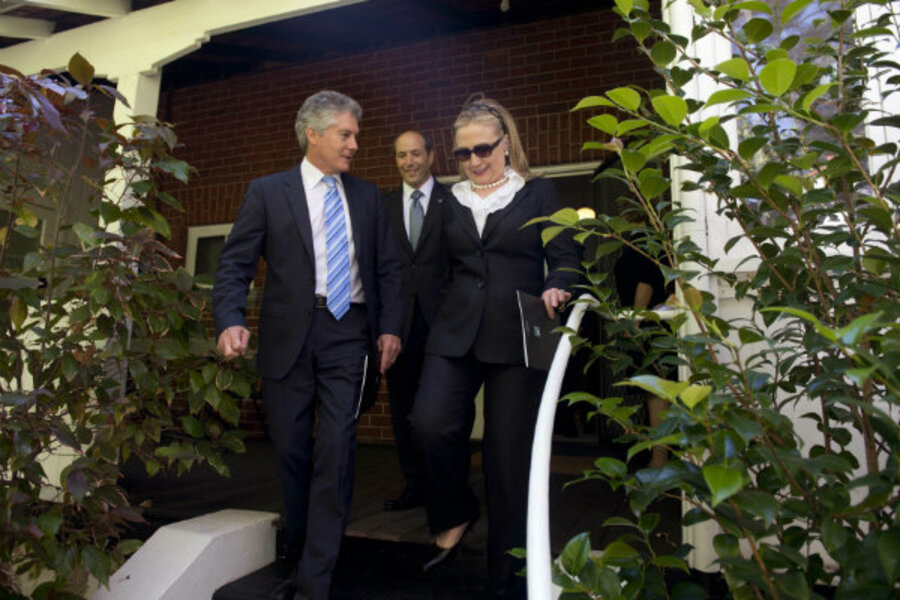Obama's post-election Syria policy is unlikely to change, but it should
Loading...
| Washington
Before the election, several domestic factors and strategic concerns constrained President Obama’s action on the Syria crisis. Fears that missteps (really, any steps) would become political fodder for Republicans and the feelings of war-weary voters conspired against a more forceful US strategy for Syria.
Now that Mr. Obama has won reelection, his administration will have fewer worries about the domestic political consequences of foreign policy decisions in his second term. But the strategic concerns about foreign intervention in Syria remain. Obama is not likely to suddenly overhaul his Syria policy, but he should.
Obama’s policy of “staying the course” or “kicking the can down the road” on Syria should ultimately be weighed against worsening strategic realities in the country and the region. Only a careful military program to help the rebels, including arming and training them, can stem the growing costs of US inaction.
The Obama administration’s cautious and pragmatic foreign policy, anchored in the president’s personality and governing style, is likely to continue, especially in Washington’s approach to Syria. Obama was and still is genuinely concerned that, in an already combustible Middle East, a US military operation against Syria, no matter how surgical, would spiral out of control and cause a widespread conflagration that would involve Israel, Iran, Hezbollah, and Hamas.
US military involvement might start as a limited campaign (a no-fly zone, air strikes, or other direct military tactics – short of boots on the ground) meant to stop the bloodshed, remove Bashar al-Assad, and secure a large chemical weapons arsenal. But it could end up with severe unintended consequences: a regional war, more bloodshed, a power vacuum that could favor jihadist elements, and weapons of mass destruction that end up in terrorist hands.
Obama also holds concerns that direct military engagement in Syria might upset his carefully crafted strategy on Iran, which he thinks is working. Obama strongly believes that his administration has achieved notable successes on the Iranian nuclear front – an effective sanctions regime that is hurting Iran’s economy and an international coalition that seems equally committed to the goal of convincing Iran to scale down its nuclear aspirations.
Neither of these developments is guaranteed to change the nuclear calculus of the Iranian leadership, but Obama likely judges that too much effort has been put into the Iranian issue over the past four years to see it ruined now by fishing in Syrian troubled waters. Syria is Iran’s only ally in the region, and US military action against the Assad regime is likely to trigger overt intervention by Iran, which could escalate into a US-Iran military conflict. Obama certainly does not want to be forced to go to war against Iran because of Syria.
While the situation in Syria is tragic and keeps worsening by the day, Obama seems to have made it clear that his top Middle East priority is Iran, not Syria. But one can make a persuasive case that the Iranian and Syrian problems are linked in important ways. Indeed, the road to concession in Tehran on the nuclear issue can be through Damascus. There may be no better way for the United States to push Iran to compromise in nuclear talks than by denying it its only strategic ally in the Arab world. Assad’s departure will give the US leverage with Iran.
But that is not the case that the Obama administration is making. Instead, it seems convinced that intervention in Syria is too risky and complicated. Better keep the Iranian and Syrian files separate.
Meanwhile, Syria is rapidly disintegrating, more than 100 people on average are dying every day, and the civil war’s spillover is destabilizing key US allies. The Assad regime also appears to be flirting with the possibility of military conflict with its neighbors, Turkey and Israel. And Al Qaeda is seriously gaining ground in the Middle East.
At what point do the costs of deteriorating conditions in Syria become intolerable for the US and force a shift in the Obama administration’s policy?
Obama has clearly stated that his red line on Syria is the movement or usage of chemical weapons by the Assad regime. (Mind you, there is a difference between “movement” and “usage” – and I would be much more concerned about the latter.) But as horrible as chemical weapons are, aren’t the previously mentioned scenarios worse? Moreover, this red line is itself weak and is not likely to deter Assad, partly because it lacks credibility. Thus far, Obama has done little to back up calls for the Assad regime’s violence to stop.
Washington desperately needs a more coherent Syria policy, of which the red line is only one part. This new policy should hinge on a comprehensive program to work with America’s Arab and NATO allies to vet, train, and arm the Syrian rebels. Secretary of State Hillary Rodham Clinton is doing the right thing by helping the Syrian political opposition get its act together. Her boss must now provide them with the military tools and training they need to overthrow the Assad regime.
Arming the rebels avoids the many pitfalls of direct military intervention (Libya-style no-fly zones or Iraq-style invasions). And it allows Syrian opposition forces to bring down the regime on their own and build alongside the political opposition a better future for their country.
Bilal Y. Saab is executive director and head of research and public affairs of the Institute for Near East and Gulf Military Analysis (INEGMA) North America. He is also a non-resident scholar with the Center for Nonproliferation Studies (CNS) at the Monterey Institute of International Studies.





